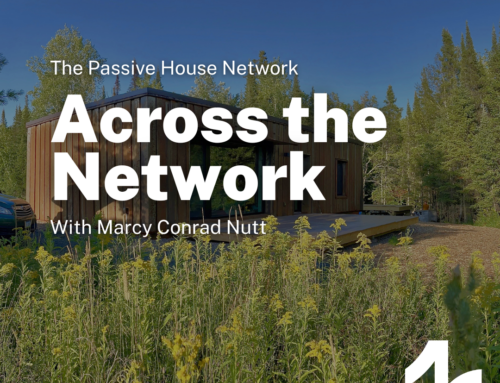October 3, 2014
This past weekend saw a lively debate on Twitter between Martin Holladay, myself and a few other Tweeps over what amounts to a few inches of insulation. It followed a very successful North American Passive House Network 2014 (NAPHN14) Conference & Expo in Maine, where I had the pleasure of seeing Martin again along with a number of additional Twitter followers and friends.
Martin gave me a great compliment at NAPHN14 saying, “(I’m) one of very few people still willing to challenge (him.)” Perhaps this wasn’t a compliment after all, but I do confess that I love a good debate with Martin. I like it for two reasons: one, it keeps him honest on Passive House-related topics (none of us – even great journalists like Martin – always gets it right); and two, it’s a good exercise in sharpening my own critical thinking and debating skills. We all know that Martin is no slouch when it comes to buildings. Exchanging ideas with him is highly engaging, with the added bonus that I typically learn something along the way.
The topic of our most recent joust is one of Martin’s favorite Passive House ‘bones.’ It has seen much heavy chewing since it first surfaced in 2011, when it was tossed up as part of a provocative keynote presentation at the Passive House Northwest Conference in Olympia, Washington. I promised him a longer explanation of my thinking than what I could squeeze into the 140-character Twitter limit. Here it is:
To preface this discussion, I include Martin’s now ‘famous’ illustration, used to support his premise (Image 1.) With it, he asks if two inches of insulation, distributed under the foundation slabs of a group of houses, is more effective than only one house with fourteen inches of insulation under it and the rest with none? Martin makes the case that the Passive House Standard – more specifically its energy modeling tool, the PHPP – drives designers to use more insulation than is necessary, and spend more money on this one item, than it currently costs to install a small amount of solar PV to offset the energy saved by the additional inches of insulation needed to meet the Passive House Standard. At the heart of this debate is the hotly contested question and apparent dilemma ‘du jour’: When is it cheaper to add solar PV rather than to install more insulation?
Firstly, let me agree with Martin, to a very limited extent. It’s not worth crunching the numbers, but I’m pretty sure that the distributed insulation shown in his illustration would likely result in more overall energy savings for each total grouping of houses. Duh. (Martin, but this not worthy of you and is a cheap setup.) Neither option is a direct result or outcome of the other. These scenarios are not mutually exclusive and implementing the Passive House Standard on one house has absolutely no connection to the rest of the houses in your illustration. Adding more insulation to one house DOES NOT PREVENT ANYONE from adding insulation under the slab of another house. There is no shortage of insulation. The argument is a ‘straw man’ and needs to be composted. Here’s a much more realistic scenario:
Let’s not dismiss Martin’s sketch entirely though. It has been very useful, more for the additional questions it has raised and as a good starting point for the very serious problems we all need to solve – and rather quickly. The graphic below (Image 3.) gives an alarming account of how little time we have left to take ‘heroic steps’ in the right direction, issued as part of a recent report by legendary number crunchers, PricewaterhouseCoopers.
It’s a great segue into my argument on why I believe Martin is chewing on the wrong two inches of bone in this debate.
You might have heard that earlier this year, California, along with a number of other regions and countries, implemented a carbon tax on gasoline as part of a broader carbon ‘cap and trade’ scheme. Without delving into the finer details, this policy is a game-changer. It commoditized an item that previously had no value, but has repeatedly been proven to have a limit on how much can be produced within the next few decades. (See Image 3.) You don’t need to be a genius, futurist, or even an economist, to recognize that as we move closer to the cap, the value of the allowed carbon approved for release will increase tremendously. Likely exponentially. This leads me to conclude that the real ‘economic comparison’ metric we all should all be using here is not the price of solar PV, but the price of carbon.
Optimizing a building design using the price of solar PV is equivalent to optimizing the design of a communication network using the price of cell phones. (A network has a durable, long-term, reasonably fixed infrastructure value. A cell phone does not.) While very few of us are currently receiving credit for more insulation than what is required by our local codes, it has a durable value. (You cannot take your sub-slab insulation with you when you move, but could theoretically take your solar PV panels.) A small part of my argument hinges on the bet that the size and cost of a solar PV array will be dwarfed by the value of the carbon a building can prove it saves. It’s a calculated bet for sure. I can hear many poo-poohing the idea as too speculative – we’re Americans! We want the cheaper option now!
So here’s the main reason why calculating your insulation investment based on the current price of solar PV is highly problematic: it doesn’t scale and does not apply universally to all projects. The solar PV cost comparison assumes that solar panels can be added to all projects. Not true. On a recent retrofit project in Sunnyvale, California, we optimized the building using the PHPP and found the sweet spot for almost every system and material, but could not ‘zero’ it out because the roof had very little solar access. Large, established redwood trees were planted directly to the south and blocked most of the sun on the roof. It was not sustainable to cut them down. Insulation was the best investment for this property and the owners are now enjoying the side benefit of an incredibly comfortable home in which to live.
The same argument applies to any larger scale building, which we MUST consider if we are going to honestly discuss ‘sustainability.’ The Bullitt Center in Seattle is a perfect example of a building with simply not enough roof space to ‘zero’ out energy use. Its solar array had to extend well beyond its property boundaries to meet its energy needs. A recent study by EcoTrust analyzed the investments made in the building and tracked their annual benefit. It confirms that the efficiency upgrades to the building far exceed those of the solar array (57% vs 18%.) This isn’t me speculating on future carbon value here – the numbers speak for themselves.
Once carbon emissions savings are measured, every little bit of extra insulation will help – whether it’s under the slab or not. Its value will be measured in saved energy, or ‘negawatts’ and will likely not be connected to the cost of energy production (with the exception of how the energy itself is generated and its own carbon saving factor.) I’m betting that our currently mythical ‘Net Zero Energy Homes’ – however one defines that empty integer – will be buried in a marketing graveyard somewhere, right next to Martin’s sub-slab insulation ‘bone.’
However, before we dismiss this idea completely, let’s revisit the small segment of projects that may actually benefit from a cost of solar vs cost of insulation approach. If we study the vast majority of our country’s urban planning design, it reveals that we favor detached homes in remote, idyllic locales. Our sprawling urban planning has created an infrastructure that locks us into a dependence on small vehicle transportation. This means that while many of us are obsessively focused on the house, we’re missing the much bigger picture. If we’re going to attempt to address the possibility of maintaining some form of life here on earth, we have to look at emissions from transportation. (My apologies for the tone here. It’s hard to not sound mildly hysterical when talking about climate change.)
California’s Air Resources Board issued a frightening graphic this year as part of a report on the GHG inventory for 2012 – by Economic Sector. It shows that in California, transportation is responsible for 37% of the total gross emissions from 2012, while residential emissions top out at 7%. Given that most states have a very similar infrastructure to California’s, and given that we are unlikely to rapidly transform our residential infrastructure into one that is car-free, this means even off-grid ‘net zero’ or regular Passive House homes may not be sufficient to reduce our overall carbon emissions to sustainable levels. Whenever possible, we will have to do more, to make up for the many other emissions our chosen lifestyle is responsible for.
Electric vehicles are not a panacea either. While they may serve as a transitional technology, they still require massive infrastructure. Roads, freeways, tunnels, bridges and parking garages all require the use of asphalt and concrete. These materials generate carbon emissions during their manufacturing process – tons of it – and are never included in vehicle Co2 emission calculations. When all these added costs and emissions are finally included in the home energy equation, our current obsessive focus on right-sizing a home’s solar PV to zero out the utility bill will soon look quaintly myopic. Anyone who builds a house now and is debating about adding a few extra inches of insulation under the slab will be wishing they had ditched the granite countertops and spent the extra money on sub-slab insulation. (I’m guessing that retrofitting insulation under a slab won’t become any easier than it is today.) The sketch we should responsibly be looking at and arguing over MUST look more like this:
When the conversation is re-framed and viewed from a perspective that includes all items related to how buildings function, where they are located, and what additional resources and services are needed to make them habitable, we may have a remote chance of fixing our very real climate problems.
This is where the NAPHN14 conference in Maine fits into the story. Given my theory, you can imagine how pleased I was to learn that the Passive House Institute is including this larger perspective in their new direction for the Passive House Standard. In his keynote address at NAPHN14 the founder of the Institute, Dr. Wolfgang Feist, explained the rationale and the calculations behind the two new Standards originally announced at the International Passive House Conference in Aachen earlier this year.
‘Passive House Plus’ and ‘Passive House Premium,’ consider carbon emissions savings with a multiplier that favors renewable generation and accounts for future developments in seasonal storage capacity for renewable energy supply. The calculation considers the time of the energy generation and use and whether it is stored, or used immediately (See Image 7.) In developing these additions to the ‘Classic’ Passive House Standard, the Passive House Institute has taken a huge leap forward to anticipate, encourage and develop buildings that make a future possible in the age of climate change.
Now, when we look back at our starting point, and then look at one last graphic generated by the Global Carbon Project (Image 9) indicating exactly who is responsible for the most carbon emissions across the globe, I’m hoping that the few hundred extra dollars you’ll pay for a couple more inches of sub-slab insulation will start to look like a bargain.
Bronwyn Barry, CPHD
Bronwyn Barry, a CPHD, Passive House California Board Member, and Co-President of the North American Passive House Network.













